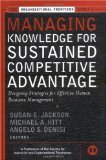Competitive Advantage and the Resource Based View of the Firm
As a follow up to my previous post titled Competitive Advantage – The Human Capital Approach, I wanted to take a second to talk a little bit about the Resource Based View of the firm that I mentioned in the previous post. Before I continue, if you are interested in this topic, definitely take a look at the book titled Managing Knowledge for Sustained Competitive Advantage: Designing Strategies for Effective Human Resource Management (affiliate link).
Most organizations don’t place a high enough focus on human capital management as a component of competitive advantage. In order for an organization to be successful in any market, they must create value for their clients. This value can be created using a new strategy, new technology or some other ‘gimmick’ but in order to sustain this value (and the competitive advantage it brings), organizations must develop and maintain an engaged, knowledgeable and creative workforce (Afiouni, 2007).
To create a workforce that provides sustainable competitive advantage and value creation, an organization must create an environment that allows their human capital to grow, much like money sitting in an interest bearing account does. This growth, expressed within people as increased knowledge, increased motivation, increased engagement, etc can be used to create competitive advantage that would be very difficult for competitors to imitate (Afiouni, 2007; Agarwal & Ferratt, 2001; Luftman & Kempaiah, 2007).
Out of the many theories of organizational behavior, one aligns itself well with the human capital view of people within an organization. This theory, called the Resource Based View (RBV), suggests that the method in which resources are applied within a firm can create a competitive advantage (Barney, 1991; Mata, Fuerst, & Barney, 1995; Peteraf, 1993; Wernerfert, 1984). The resource based view of firms is based on two main assumptions: resource diversity and resource immobility (Barney, 1991; Mata et al., 1995). According to Mata et al. (1995), these assumptions are defined as:
- Resource diversity (also called resource heterogeneity) pertains to whether a firm owns a resource or capability that is also owned by numerous other competing firms, then that resource cannot provide a competitive advantage.
- As an example of resource diversity, consider the following: a firm is trying to decide whether to implement a new IT product. This new product might provide a competitive advantage to the firm if no other competitors have the same functionality. If competing firms have similar functionality, then this new IT product doesn’t pass the ‘resource diversity’ test and therefore doesn’t provide a competitive advantage.
- Resource immobility refers to a resource that is difficult to obtain by competitors because the cost of developing, acquiring or using that resource is too high.
- As an example of resource immobility, consider the following: a firm is trying to decide whether they should buy an ‘off-the-shelf’ inventory control system or have one built specifically for their needs. If they buy an off-the-shelf system, they will have no competitive advantage over others in the market because their competition can implement the same system. If they pay for a customized solution that provides specific functionality that only they implement, then they will have a competitive advantage, assuming the same functionality isn’t available in other products.
These two assumptions can be used to determine whether an organization is able to create a sustainable competitive advantage by providing a framework for determining whether a process or technology provides a real advantage over the marketplace.
The resource based view of the firm suggests that an organization’s human capital management practices can contribute significantly to sustaining competitive advantage by creating specific knowledge, skills and culture within the firm that are difficult to imitate (Afiouni, 2007; Mata et al., 1995). In other words, by creating resource diversity (increasing knowledge and skills) and/or resource immobility (a culture that people want to work in), sustainable competitive advantage can be created and maintained.
In order to create human capital resource diversity and immobility, an organization must have adequate human capital management practices, organizational processes, knowledge management practices and systems, educational opportunity (both formal and informal) and social interaction (i.e., community building) practices in place (Afiouni, 2007; Barney, 1991; Mata et al., 1995; Schafer, 2004).
NOTE: I am finishing up a White paper on the topic of Competitive Advantage & Human Capital and hope to have it available within the next week or so…check back soon.
References
- Afiouni, F. (2007). Human Resource Management and Knowledge Management: A Road Map Toward Improving Organizational Performance. Journal of American Academy of Business, Cambridge, 11(2), 124.
- Agarwal, R., & Ferratt, T. W. (2001). Crafting an HR strategy to meet the need for IT workers. Association for Computing Machinery. Communications of the ACM, 44(7), 58.
- Barney, J. B. (1991). Firm resources and sustained competitive advantage. Journal of Management, 17(1), 99-120.
- Luftman, J., & Kempaiah, R. M. (2007). The IS Organization of the Future: The IT Talent Challenge. Information Systems Management, 24(2), 129.
- Mata, F. J., Fuerst, W. L., & Barney, J. B. (1995). Information technology and sustained competitive advantage: A resource-based analysis. MIS Quarterly, 19(4), 487.
- Peteraf, M. (1993). The cornerstones of competitive advantage: A resource-based view. Strategic Management Journal, 14, 179-191.
- Schafer, M. (2004). Why Workforce Management Is Back In Style. Optimize, 67.
- Wernerfert, B. (1984). A resource based view of the firm. Strategic Management Journal, 5, 171-180.
[tags] competitive advantage, technology, resource based view of the firm, human capital, organization [/tags]




Comments ()